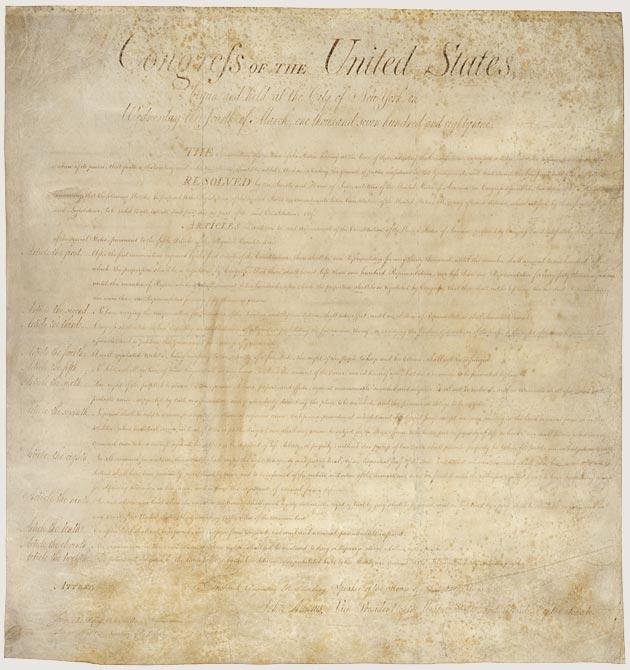Introduction
The National Archives contain numerous founding documents of America. One of them is the Bill of Rights, a list of amendments to the Constitution (“The Bill of Rights: How did it happen,” 2017). As can be seen in Figure 1, the Bill of Rights contains ten amendments ratified by the First Congress of the US. The Bill’s text includes the guidelines for protecting people’s freedom of speech, press, assembly, and protest. Moreover, the separation of religion and the government was also one of the first additions ratified by the Congress. Other amendments include protection of private property, secure private information, and fair sentencing. One of the points also involves the right to bear arms, although the extents of this particular amendment are not explicit.

This document was created as an attempt to placate the opposition of the new government formed by some citizens and George Mason. It was designed in 1789 and proposed to the Congress by James Madison, one of the founding fathers and a former president of the US. Madison was unsupportive of adding amendments to the Constitution but later agreed to give citizens more rights and protections in order to bring balance to the relationship between the government and the civilians. Therefore, the process of the Bill’s creation did not involve guidelines that would significantly alter the federal governmental structure. Instead, Madison focused on issues that could interest voters and be positively received by the Congress (“The Bill of Rights: How did it happen,” 2017).
History
The history of the Bill of Right’s creation reveals many interesting facts about the political and personal concerns of American citizens. Historically, the focus on independence from other countries that led to the establishment of the US as a separate entity shifted towards the emphasis on personal liberties and a general mistrust for the government (“The Bill of Rights: How did it happen,” 2017), People opposed the Constitution and believed that they needed more security measures to protect their freedoms. Thus, the Bill was created as an answer to people’s inquiries, which also shows how valuable the public’s word can be for the government.
Contemporary Influence
Every Amendment of the Bill of Rights has an impact on contemporary issues because it is an inherent part of every American’s political identity. However, some of the points are more discussed than others. For instance, the study by Blocher and Miller (2016) investigates one of the most debated modern issues that are directly impacted by the Bill of Rights, namely the right to bear arms. The attempts of the government to create and implement gun control rules in order to establish some regulatory procedures for gun owners are met with citizens addressing the Second Amendment. This point of the Fill states that the federal law protects the right of people to have weapons. Here, the influence of the Bill is apparent as it forms the citizens’ perception of this issue and completely negates any possible opposition.
Conclusion
Such an attitude towards the Bill of Rights shows that the public still considers this document to be one of the most important pieces of the US history and identity. The reliance of American on different amendments show the extent to which they are devoted to the guidelines put forth by the country’s founding fathers. The Bill of Rights can be considered as a symbol of people’s authority and independence and reveals the nature of the cultural identity of the US. The strong support of the Second Amendment, for instance, allows US citizens to oppose any proposed regulations and put all focus on their personal freedoms.
References
The Bill of Rights [Image]. (2017). Web.
The Bill of Rights: How did it happen? (2017). Web.
Blocher, J., & Miller, D. A. (2016). What is gun control? Direct burdens, incidental burdens, and the boundaries of the Second Amendment. The University of Chicago Law Review, 295-355.